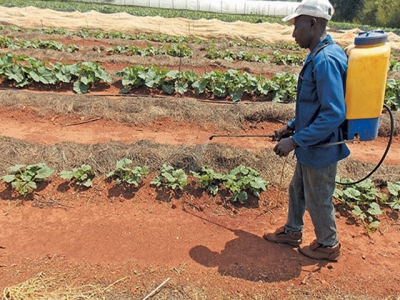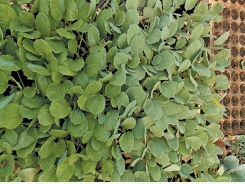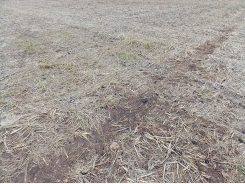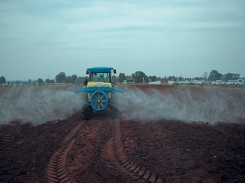Using a knapsack sprayer on a big farm

Many farmers think that using a knapsack sprayer is taking a step backwards as large spray rigs are fast and effective. However, knapsack sprayers still have their uses on big farms.
A knapsack sprayer can be highly economical, as in this case: spraying cucurbits with boron where there are large gaps between rows. Photo: Bill Kerr
The first is for spot spraying. Cabbage farmers often find a plant here and there that is infested with aphids. These are easy to identify, as cabbage aphids make the leaves curl and leave distinct white marks.
Instead of using the tractor-mounted sprayer to treat the land, go through it with a knapsack and spray only the infected plants. You will be able to spray them far more thoroughly, kill the entire colony and save on tractor costs and insecticide.
Aphids sometimes enter the land and colonise young cabbages. When the transplants are about a month old, the aphids settle on the growth tip and are difficult to control with a boom sprayer. In this case, move from plant to plant with a knapsack, concentrating the spray onto this area only.
Penetration will be far better than with a tractor-mounted sprayer, the boom of which will also cover the open ground between plants, leading to waste.
It is not even necessary to wet the outer section of the leaves. Concentrate on the inner part, as this can remain a source of continual re-infection if not properly sprayed.
This method is highly economical, as you can average one plant per second and cover 1ha in a day.
Remember, though, to spray only one row on the same pass; spraying the rows to left and right slows the process down. To save more time, provide your worker with a drum of mixed product.
Because you’re not wasting chemicals, you may even be able to afford more effective products.
Spot-spraying is also useful in the case of a weed such as nutgrass that requires glyphosate. Here, regrowth generally occurs in patches, or as a plant emerging here and there; with a knapsack you can concentrate on spraying these.
An improved version
While working for a processing company years ago, I made a two-nozzle boom for a knapsack in order to spray weeds between bean rows. By using tapered jet nozzles and holding them at a height where they just wet the lower leaves, I could use Basagran herbicide at one-third of the recommended rate. I sprayed when the weeds were smaller and obtained far better results with less stress on the beans – and saved money on herbicide.
Diaphragm rather than plunger
When selecting a knapsack sprayer, choose a model that builds pressure from a diaphragm rather than one equipped with a plunger. The former provides pressure with less effort and there are fewer parts that can break down.
When I worked on a large agricultural estate, we used plunger-type knapsack sprayers extensively to control weeds under fruit trees. As I was responsible for their maintenance, I was very conscious of the cost of parts and the time spent on keeping them in working order!
During my time there, a new plastic model with a diaphragm came onto the market and the company gave me one to try out. I used it non-stop for a year and it gave no trouble whatsoever. On my advice, the agricultural estate switched over to these knapsack sprayers.
Related news
Tools

Phối trộn thức ăn chăn nuôi

Pha dung dịch thủy canh

Định mức cho tôm ăn

Phối trộn phân bón NPK

Xác định tỷ lệ tôm sống

Chuyển đổi đơn vị phân bón

Xác định công suất sục khí

Chuyển đổi đơn vị tôm

Tính diện tích nhà kính

Tính thể tích ao




 Sandy soil: a guide to working with it
Sandy soil: a guide to working with it  Getting nozzle size and pressure right
Getting nozzle size and pressure right